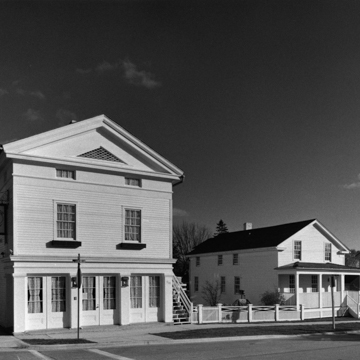The Cole Historic District offers a rare vignette of a mid-nineteenth century Wisconsin village. The Greek Revival Cole Store (1848; 504 Water Street) has three sets of French doors, a large pediment across the front, pedimented dormers along the side walls, and small attic windows in the frieze. Charles Cole, who lived above his store, was perhaps the most significant figure in the early development of Sheboygan Falls. He owned the local gristmill, a sash and door factory, and a lumberyard, and he also served as postmaster and the area’s temperance leader. Cole and his family lived next door at 508 Water before their store was erected. Built in 1842, the one-and-a-half-story residence is in a simplified Greek Revival style.
The Rochester Lumber Company built the adjacent Mill House (1837; 516–518 Water) to board its mill workers. This, the oldest extant building in Sheboygan County, is a symmetrical two-story structure, with a regular rhythm of windows and corner entrances. In 1860, Cole purchased the boarding house for two of his sons, who created a duplex by dividing the house with a partition wall and adding summer kitchens to the rear. Restored in 1986, the structure now houses the Sheboygan County Historical Research Center.















